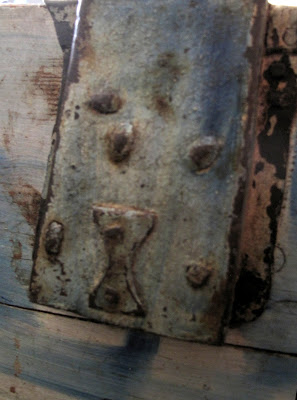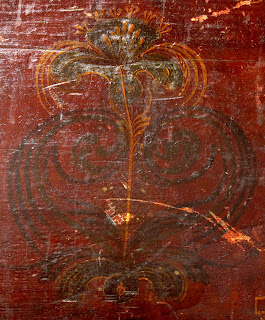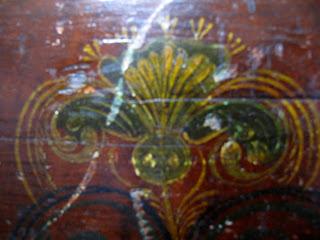 |
| A hand made painted and rosemaled decorated Norwegian immigrant dower chest inscribed with the name Magdeli Jahns dr [dotter] Laupsa 1889. |

 To Display this chest the last day of the old year ending, the new year beginning, both chest and year represent a way of life that you may think no longer exists, but it does, and is chronicled here, close on the heels of present virtuality. An app where speech itself is superseded and thought is made into text. However, since you don't know what you think until you speak, the mind is essentially inchoate in communicating with its physical vessel without the medium of speech, and must make simple its multifarious instructions to communicate with the physical--that is the purpose to illustrate how this happens in the speech and writing and writing of this chest. Some pains are taken to explain this in Language In Voices Out and The Alien Voice.
To Display this chest the last day of the old year ending, the new year beginning, both chest and year represent a way of life that you may think no longer exists, but it does, and is chronicled here, close on the heels of present virtuality. An app where speech itself is superseded and thought is made into text. However, since you don't know what you think until you speak, the mind is essentially inchoate in communicating with its physical vessel without the medium of speech, and must make simple its multifarious instructions to communicate with the physical--that is the purpose to illustrate how this happens in the speech and writing and writing of this chest. Some pains are taken to explain this in Language In Voices Out and The Alien Voice.
 It seems this chest was made for the young woman Magdeli to come to America, if only because that is where it ended up, in Prescott, Arizona, at an auction with the effects of an old family. It had another box on top as it rested on the auction floor. We removed this and stood guard to prevent any further scratches. It is painted a blue swirl
It seems this chest was made for the young woman Magdeli to come to America, if only because that is where it ended up, in Prescott, Arizona, at an auction with the effects of an old family. It had another box on top as it rested on the auction floor. We removed this and stood guard to prevent any further scratches. It is painted a blue swirl on the inside top and till, and down two thirds toward the bottom. Two folio sized pages of writing were folded up inside the till. The writing was in ink, in a flowing assured hand on a sturdy ruled tablet paper. I scanned it at the time and it seemed a meditation upon a wedding, hence, a dower chest, but it celebrates a dower for the Wedding of Christ and the church. The writing references King Solomon, but with such poetic speaking as if it were written by Donne with the assurance of Blake. The writing of the decorated outside is Norwegian, but this written proclamation is in British, as is clear from its spellings. No results yet for the author, but a number of efforts were tried.
on the inside top and till, and down two thirds toward the bottom. Two folio sized pages of writing were folded up inside the till. The writing was in ink, in a flowing assured hand on a sturdy ruled tablet paper. I scanned it at the time and it seemed a meditation upon a wedding, hence, a dower chest, but it celebrates a dower for the Wedding of Christ and the church. The writing references King Solomon, but with such poetic speaking as if it were written by Donne with the assurance of Blake. The writing of the decorated outside is Norwegian, but this written proclamation is in British, as is clear from its spellings. No results yet for the author, but a number of efforts were tried.  For anybody who loves Pennsylvania chests, this chest and its decoration offer contrasts and similarities of several kinds. It feels as if it was hand made by her father from thick barn wood. The bottoms boards have shrunk. It is held by irregularly spaced dovetails and black iron hasps, hinges and lock. The front is rosemaled, the background and the whole painted brown, and looks as if the front were varnished. It is painted black below and above the center hasp in front and up the sides to mimic the ironwork.
For anybody who loves Pennsylvania chests, this chest and its decoration offer contrasts and similarities of several kinds. It feels as if it was hand made by her father from thick barn wood. The bottoms boards have shrunk. It is held by irregularly spaced dovetails and black iron hasps, hinges and lock. The front is rosemaled, the background and the whole painted brown, and looks as if the front were varnished. It is painted black below and above the center hasp in front and up the sides to mimic the ironwork.
Both floral designs of the front panel are hand painted with slight differences. Leaves form orange swirls downward to meet black swirls coming up from the pedestal base or foot of the design. Each panel is enclosed in squares of orange.
Flower petals go up the black strips on the ends painted to look like metal, also in the center under the lock, which is in the shape of a heart, further evidence of dower.
The whole is painted brown with an overlay of varnish. The sides are irregularly dovetailed, showing they were hand done. Metal straps hinged in the back extend over and down the top from the back to the lip.
The content suggests Donne. The British spelling of centre in the third paragraph suggests that generic origin. The fourth paragraph, "before us today" suggests a public address, a sermon. The many references to her attire are bolded to show the fine linen in every such chest.
***
Here is the text:
Eph 5- 15-21 Matt 22. 1-14 “Come behold King Solomon, with the crown wherewith his mother crowned him in the day of his espousals, in the day of the rejoicing of his heart.”
Eph 5- 15-21 Matt 22. 1-14 “Come behold King Solomon, with the crown wherewith his mother crowned him in the day of his espousals, in the day of the rejoicing of his heart.”
It was written for Him, who was greater than Solomon. Mother earth of whose substance his body is composed—thrust a crown of thorns upon his head, in the day of His suffering and death. He would not take the crown before His resurrection, because in His death, all nature died: in His resurrection the new creation first appeared.
The resurrection of Jesus was His true divine birth as man into that condition in which God had determined that man should be. Jesus is the only true man, the only one, on whom the eye of God can rest with satisfaction, the only one who fulfills God’s purpose when He said “Let us make man in our image.”
Around Him all the cycles of time revolve, all the purposes of God from the beginning (when there was no man) centre in Him. All the mighty acts of God in heaven and earth and under earth have in Him their chief doer. Is there treasure hid in the field? He it is who searches for it. Is there a goodly pearl? He is the merchant, who sells all that He has, that He may buy that pearl. Is there a sheep lost from the fold of God? He it is who leaves the ninety and nine who never strayed and seeks the lost one till he finds it and bringeth it home on his shoulders rejoicing. A world restored! Not one of them is lost.
And so we have before us today the climax, the crowning act in the salvation of our race, the marriage of the King’s son, and His Coronation.
He would not take the crown when offered it upon earth! He would not take the crown when He sat down at the right hand of the majesty on high! He would not take the crown without His bride.
The prophetic scriptures give us two views of the woman the church; the one sits a queen before the time without Her Lord, without them who wait their resurrection. Of the other it is said “Unto her it was granted that she should clothed in fine linen, clean and white for the fine linen is the righteousness of saints. It is the wedding garment provided by the King. The King’s servants clothe the guests therewith freely.
It is not a splendid vesture covering filthy rags, the defilement remaining beneath such a condition would be horrible even upon the earth, how much more so in the presence of the King? It is the righteousness of Christ imputed to us, imparted to us, in wrought in us. The righteousness of Christ indeed! Made effectual by the Holy Ghost in purging out the old nature, and assimilating our character with His so that we also become righteous.
It is a gradual painful self sacrificing work but necessary for we know that “without holiness, no man will see the Lord” and into those pure gates “Entereth nothing that defileth or maketh a lie.”
The King’s daughter is all glorious within; his clothing is of wrought gold.” She shall be brought unto the King in raiment of needle work with gladness and rejoicing shall they be brought, they shall enter into the King’s palace. Instead of thy fathers shall by thy children, whom thou mayest make princes in all the earth – when the First fruits are caught away—there is heard a loud voice in Heaven saying “Now is come salvation and strength, and the Kingdom of God, and the power of his Christ wherefore rejoice ye heavens, and ye that dwell in them.
When Babylon is destroyed – “the four and twenty elders, and the four living creatures, fall down and worship God that sat upon the throne saying Amen, hallelujah and a voice came out of the throne saying Praise our God all ye his servants small & great, and I heard the voice of a great multitude, and as the voice of great waters, and as the voice of might thunderings saying Allelujah For the Lord God omnipotent reigneth. Let us be glad and rejoice, and give honour to Him For the marriage of the Lamb is come, and His wife hath made herself ready- Then shall the Heavens rejoice and the earth be glad. Then shall the sea roar and the fullness thereof.”
Then shall creation which once grew for Him a crown of thorns yield Him such honour, that it shall be said to all the intelligent beings around the throne of God “Come see King Solomon with the crown wherewith his mother crowned Him, in the day of His espousals, in the day of the rejoicing of His heart.
When we meditate on these things we think, who is sufficient for them? Let us who are strengthened by the Cup of Salvation, and the bread of everlasting life answer joyfully By the grace of God we are.
And unto the Father and to the Son and to the Holy Ghost only as be ascribed in the Church all honour & glory, might, majesty, dominion and blessing now henceforth and forever. Amen.
Let this be the call for the new year. We no more have such chest but shall get them.
 |
After bidding for the chest we found the marriage troth handwritten in the till:
“Come
behold King Solomon, with the crown wherewith his mother crowned
him in the day of his espousals, in the day of the rejoicing of his heart.” Chests of old wood, fraktur, rosemaling, folk arts are as extinct to us as electricity soon enough. The new chair of the Joint Chiefs, Martin Dempsey, worries that the lack of redundancy in the internet puts all our social-technical systems at risk. Redundancy means here also that books, chests, linens, crafts, even writing itself, all things done by hand, set aside by the virtual machine invention will incapacitate society in their loss, for there is an app where typing is superseded and speech is automatically translated to text. This results in much loss of mental clarity and depth, for syntactic relations make new pathways in the brain that establish cognitive grasp.
Comparisons to follow in the manufacture of brain pathways Faulkner's sentences produce great mental strength in those who read them.
|















